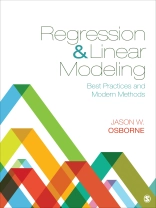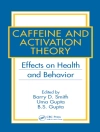In a conversational tone,
Regression & Linear Modeling provides conceptual, user-friendly coverage of the generalized linear model (GLM). Readers will become familiar with applications of ordinary least squares (OLS) regression, binary and multinomial logistic regression, ordinal regression, Poisson regression, and loglinear models. The author returns to certain themes throughout the text, such as testing assumptions, examining data quality, and, where appropriate, nonlinear and non-additive effects modeled within different types of linear models.
Зміст
Chapter 1: A Nerdly Manifesto
The Variables Lead the Way
Different Classifications of Measurement
It’s All About Relationships!
A Brief Review of Basic Algebra and Linear Equations
The GLM in One Paragragh
A Brief Consideration of Prediction
A Brief Primer on Null Hypothesis Statistical Testing
A Tale of Two Errors
What Conclusions Can We Draw Based on NHST Results?
So What Does Failure to Reject the Null Hypothesis Mean?
Moving Beyond NHST
The Importance of Replication and Generalizability
Where We Go From Here
Enrichment
Chapter 2: Basic Estimation and Assumptions
Estimation and the GLM
What Is OLS Estimation?
ML Estimation—A Gentle but Deeper Look
Assumptions for OLS and ML Estimation
Simple Univariate Data Cleaning and Data Transformations
What If We Cannot Meet the Assumptions?
Where We Go From Here
Enrichment
Chapter 3: Simple Linear Models With Continuous Dependent Variables: Simple Regression Analyses
Advance Organizer
It’s All About Relationships!
Basics of the Pearson Product-Moment Correlation Coefficient
Calculating r
Effect Sizes and r
A Real Data Example
The Basics of Simple Regression
Basic Calculations for Simple Regression
Standardized Versus Unstandardized Regression Coefficients
Hypothesis Testing in Simple Regression
A Real Data Example
Does Centering or z-Scoring Make a Difference?
Some Simple Multivariate Data Cleaning
Summary
Enrichment
Chapter 4: Simple Linear Models With Continuous Dependent Variables: Simple ANOVA Analyses
Advance Organizer
It’s All About Relationships! (Part 2)
Analyzing These Data via t-Test
Analyzing These Data via ANOVA
ANOVA Within an OLS Regression Framework
When Your IV Has More Than Two Groups: Dummy Coding Your Unordered Polytomous Variable
Smoking and Diabetes Analyzed via ANOVA
Smoking and Diabetes Analyzed via Regression
What If the Dummy Variables Are Coded Differently?
Unweighted Effects Coding
Weighted Effects Coding
Common Alternatives to Dummy or Effects Coding
Summary
Enrichment
Chapter 5: Simple Linear Models With Categorical Dependent Variables: Binary Logistic Regression
Advance Organizer
It’s All About Relationships! (Part 3)
The Linear Probability Model
How Logistic Regression Solves This Issue: The Logit Link Function
A Brief Digression Into Probabilities, Conditional Probabilities, and Odds
Simple Logistic Regression Using Statistical Software
The Logistic Regression Equation
Interpreting the Constant
What If You Want CIs for the Constant?
Summary So Far
Logistic Regression With a Continuous IV
Some Best Practices When Using a Continuous Variable in Logistic Regression
Testing Assumptions and Data Cleaning in Logistic Regression
Hosmer and Lemeshow Test for Model Fit
Summary
Enrichment
Appendix 5A: A Brief Primer in Probit Regression
Chapter 6: Simple Linear Models With Polytomous Categorical Dependent Variables: Multinomial and Ordinal Logistic Regression
Advance Organizer
Understanding Marijuana Use
Dummy-Coded DVs and Our Hypotheses to Be Tested
Basics and Calculations
Multinomial Logistic Regression (Unordered) With Statistical Software
Multinomial Logistic Regression With a Continuous Predictor
Multinomial Logistic Regression as a Series of Binary Logistic Regressions
Data Cleaning and Multinomial Logistic Regression
Testing Whether Groups Can Be Combined
Ordered Logit (Proportional Odds) Model
Assumptions of the Ordinal Logistic Model
Interpreting the Results of the Ordinal Regression
Interpreting the Intercepts/Thresholds
Interpreting the Parameter Estimates
Data Cleaning and More Advanced Models in Ordinal Logistic Regression
The Measured Variable is Continous, Why Not Just Use OLS Regression for This Type of Analysis?
A Brief Note on Log-Linear Analyses
Summary and Conclusions
Enrichment
Chapter 7: Simple Curvilinear Models
Advance Organizer
Zeno’s Paradox, a Nerdy Science Joke, and Inherent Curvilinearity in the Universe…
A Brief Review of Simple Algebra
Hypotheses to Be Tested
Illegitimate Causes of Curvilinearity
Detection of Nonlinear Effects
Basic Principles of Curvilinear Regression
Curvilinear OLS Regression Example: Size of the University and Faculty Salary
Data Cleaning
Interpreting Curvilinear Effects Effectively
Reality Testing This Effect
Summary of Curvilinear Effects in OLS Regression
Curvilinear Logistic Regression Example: Diabetes and Age
Curvilinear Effects in Multinomial Logistic Regression
Replication Becomes Important
More Fun With Curves: Estimating Minima and Maxima as Well as Slope at Any Point on the Curve
Summary
Enrichment
Chapter 8: Multiple Independent Variables
Advance Organizer
The Basics of Multiple Predictors
What Are the Implications of This Act?
Hypotheses to Be Tested in Multiple Regression
Assumptions of Multiple Regression and Data Cleaning
Predicting Student Achievement From Real Data
Testing Assumptions and Data Cleaning in the NELS88 Data
Methods of Entering Variables
Using Multiple Regression for Theory Testing
Logistic Regression With Multiple IVs
Assessing the Overall Logistic Regression Model: Why There Is No R2 for Logistic Regression
Summary and conclusions
Exercises
Chapter 9: Interactions Between Independent Variables: Simple moderation
Advance Organizer
What is an Interaction?
Procedural and Conceptual Issues in Testing for Interactions Between Continuous Variables
Procedural and Conceptual Issues in Testing for Interactions Containing Categorical Variables
Hypotheses to Be Tested in Multiple Regression With Interactions Present
An OLS Regression Example: Predicting Student Achievement From Real Data
Interpreting the Results From a Significant Interaction
Graphing Interaction Effects
An Interaction Between a Continuous and a Categorical Variable in OLS Regression
Interactions With Logistic Regression
Example Summary of Interaction Analysis
Interactions and Multinomial Logistic Regression
Example Summary of Findings
Can These Effects Replicate?
Post Hoc Probing of Interactions
Summary
Enrichment
Chapter 10: Curvilinear Interactions Between Independent Variables
Advance Organizer
What is a Curvilinear Interaction?
A Quadratic Interaction Between X and Z
A Cubic Interaction Between X and Z
A Real-Data Example and Exploration of Procedural Details
Curvilinear Interactions Between Continuous and Categorical Variables
Curvilinear Interactions With Categorical DVs (Multinomial Logistic)
Curvilinear Interaction Effects in Ordinal Regression
Chapter Summary
Enrichment
Chapter 11: Poisson Models: Low-Frequency Count Data as Dependent Variables
Advance Organizer
The Basics and Assumptions of Poisson Regression
Why Can’t We Just Analyze Count Data via OLS, Multinomial, or Ordinal Regression?
Hypotheses Tested in Poisson Regression
Poisson Regression With Real Data
Interactions in Poisson regression
Data Cleaning in Poisson Regression
Refining the Model by Eliminating Excess (Inappropriate) Zeros
A Refined Analysis With Excess Zeros Removed
Curvilinear Effects in Poisson Regression
Dealing With Overdispersion or Underdispersion
Negative Binomial Model
Summary and Conclusions
Enrichment
Chapter 12: Log-Linear Models: General Linear Models When All of Your Variables Are Unordered Categorical
Advance Organizer
The Basics of Loglinear Analysis
Hypotheses Being Tested
Assumptions of Loglinear Models
A Slightly More Complex Loglinear Model
Can We Replicate These Results in Logistic Regression?
Data Cleaning in Loglinear Models
Summary and Conclusions
Enrichment
Chapter 13: A Brief Introduction to Hierarchical Linear Modeling
Advance Organizer
Why HLM models Are Necessary
How Do Hierarchical Models Work? A Brief Primer
Generalizing the Basic HLM Model
Residuals in HLM
Results of DROPOUT Analysis in HLM
Summary and Conclusions
Enrichment
Chapter 14: Missing Data in Linear Modeling
Advance Organizer
Not All Missing Data Are the Same
Categories of Missingness: Why Do We Care If Data Are MCAR or Not?
How Do You Know If Your Data Are MCAR, MAR, or MNAR?
What Do We Do With Randomly Missing Data?
Data MCAR
Data MNAR
How Missingness Can Be an Interesting Variable in and of Itself
Summing Up: Benefits of Appropriately Handling Missing Data
Enrichment
Chapter 15: Trustworthy Science: Improving Statistical Reporting
Advance Organizer
What Is Power, and Why Is It Important?
Power in Linear Models
Summary of Points Thus Far
Who Cares as Long as p < .05? Volatility in Linear Models
A Brief Introduction to Bootstrap Resampling
Summary and Conclusions
Enrichment
Chapter 16: Reliable Measurement Matters
Advance Organizer
A More Modern View of Reliability
What is Cronbach’s Alpha (and What Is It Not)?
Factors That Influence Alpha
What Is “Good Enough” for Alpha?
Reliability and Simple Correlation or Regression
Reliability and Multiple IVs
Reliability and Interactions in Multiple Regression
Protecting Against Overcorrecting During Disattenuation
Other (Better) Solutions to the Issue of Measurement Error
Does Reliability Influence Other Analyses, Such as Analysis of Variance?
Reliability in Logistic Models
But Other Authors Have Argued That Poor Reliability Isn’t That Important. Who Is Right?
Sample Size and the Precision/Stability of Alpha-Empirical CIs
Summary and Conclusions
Chapter 17: Prediction in the Generalized Linear Model
Advance Organizer
Prediction vs. Explanation
How is a Prediction Equation Created?
Shrinkage and Evaluating the Quality of Prediction Equations
An Example Using Real Data
Improving on Prediction Models
Calculating a Predicted Score, and CIs Around That Score
Prediction (Prognostication) in Logistic Regression (and Other) Models
An Example of External Validation of a Prognostic Equation Using Real Data
External Validation of a Prediction Equation
Using Bootstrap Analysis to Estimate a More Robust Prognostic Equation
Summary
Chapter 18: Modeling in Large, Complex Samples: The Importance of Using Appropriate Weights and Design Effect Compensation
Advance Organizer
What Types of Studies Use Complex Sampling?
Why Does Complex Sampling Matter?
What Are Best Practices in Accounting for Complex Sampling?
Does It Really Make a Difference in the Results?
Conditions Used
Comparison of Unweighted Versus Weighted Analyses
Summary
Enrichment
Про автора
Jason W. Osborne is a thought leader and professor in higher education. His background in educational psychology, statistics and quantitative methods, along with that gleaned from high-level positions within Academia gives a unique perspective on the real-world data factors. In 2015, he was appointed Associate Provost and Dean of the Graduate School at Clemson University in Clemson, South Carolina. As well as Associate Provost, at Clemson University, Jason was a Professor of applied statistics at the School of Mathematical Sciences, with a secondary appointment in Public Health Science. In 2019, he took on the role of Provost and Executive VP for Academic Affairs at Miami University. As Provost, Jason implemented a transformative strategic plan to reposition the institution as one prepared for new challenges with a modern, compelling curriculum, a welcoming environment, and enhanced support for student faculty positions and staff. In 2021, he was named by Stanford University as one of the top 2% researchers in the world, underlining his commitment to world-class research methods across particular domains, ultimately influencing a generation of learners. Currently, Jason teaches and publishes on data analysis ‘best practices’ in quantitative and applied research methods. He has served as evaluator or consultant on research projects and in public education (K-12), instructional technology, health care, medicine and business. He served as founding editor of Frontiers in Quantitative Psychology and Measurement and has been on the editorial boards of several other journals (such as Practical Assessment, Research, and Evaluation). Jason W Osborne also publishes on identification with academics and on issues related to social justice and diversity. He has written seven books covering topics to communicate logistic regression and linear modeling, exploratory factor analysis, best practices and modern research methods, data cleaning, and numerous other topics.












